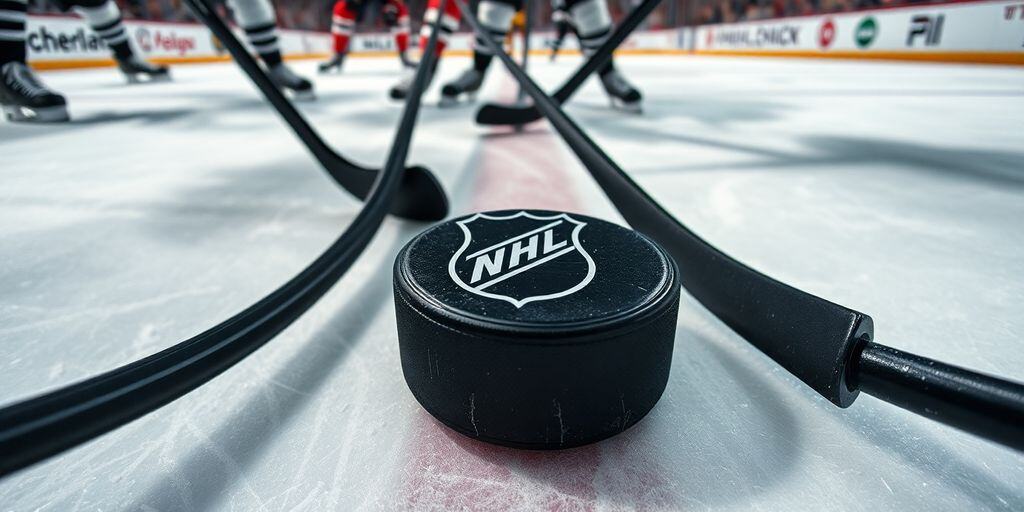As the NHL season progresses, understanding the strength of schedule becomes vital for analyzing team performances. In 2025, various factors play a role in how teams navigate their schedules, impacting everything from travel to coaching strategies. This article breaks down the key elements that influence the NHL strength of schedule and how they affect overall team success.
Key Takeaways
- The strength of schedule significantly affects a team’s performance throughout the season.
- Travel fatigue can hinder player performance, especially during back-to-back games.
- Matchups against stronger opponents can reveal weaknesses in a team’s strategy.
- Coaching experience and adaptability are crucial in managing schedule-related challenges.
- Fan engagement is influenced by how teams perform against their scheduled opponents.
Understanding NHL Strength Of Schedule Metrics

Defining Strength Of Schedule
Okay, so when we talk about "strength of schedule" in the NHL, we’re really asking: how tough is a team’s lineup of games? It’s not just about the number of games, but who they’re playing and when. A team facing mostly top contenders will have a harder time than one playing mostly weaker teams. It’s pretty intuitive, but getting a good handle on it is key for understanding a team’s performance.
Think of it like this:
- Opponent Win Percentage: A common way to measure SOS is by looking at the average win percentage of a team’s opponents. Higher percentage = tougher schedule.
- Points Percentage: Some analysts prefer using points percentage (points earned divided by possible points) for a more accurate picture, especially with overtime/shootout wins.
- Future Games: It’s tricky, but you can even try to project the strength of opponents future performance, though that gets into prediction territory.
Importance Of Schedule Difficulty
Why does any of this matter? Well, a team’s record alone doesn’t tell the whole story. A team with a great record might have had an easy NHL schedule, while a team with a mediocre record might have battled through a gauntlet. Understanding schedule difficulty helps us:
- Evaluate Team Performance Fairly: It provides context for wins and losses.
- Identify Potential Overachievers/Underachievers: Teams exceeding expectations despite a tough schedule are worth a closer look.
- Predict Future Success: A team that struggled early with a tough schedule might be poised for a strong finish when things ease up.
It’s easy to look at the standings and assume you know who’s good and who isn’t. But strength of schedule adds a layer of depth. It forces you to ask, "Did they earn that record, or was it handed to them?"
Historical Trends In Scheduling
Has scheduling always been this way? Not exactly. The NHL schedule has evolved over the years, and there are some interesting trends to note. For example, the league has tried to reduce back-to-back games and long road trips to improve player safety and game quality. Also, the introduction of more balanced schedules (where teams play each other more often) has aimed to make strength of schedule more equitable across the league. But, regional rivalries and conference matchups still play a big role. Here’s a simplified look at how things have changed:
| Era | Scheduling Focus | Impact on SOS |
|---|---|---|
| Pre-2000s | Emphasis on divisional/conference games | Significant SOS variation based on division strength |
| 2000s-2010s | Increased inter-conference play | More balanced SOS, but travel demands increased |
| 2020s | Focus on reducing travel, back-to-backs | Attempts to equalize SOS while prioritizing player well-being |
Impact Of Travel On Team Performance
Travel Fatigue Factors
Okay, so everyone knows travel is rough, but in the NHL, it’s next-level. Think about it: constant flights, different time zones, weird hotel beds, and trying to maintain peak performance. It’s a recipe for disaster. The cumulative effect of travel significantly impacts player energy levels and overall team performance.
- Sleep deprivation messes with everything.
- Changes in diet throw players off.
- The mental strain of being away from home adds up.
Home vs. Away Game Dynamics
Home ice advantage is a real thing, and it’s not just about the crowd. Teams play better at home because they’re comfortable, rested, and in their routine. Away games? Total opposite. You’re dealing with hostile crowds, unfamiliar ice, and the pressure to perform under less-than-ideal circumstances. It’s a huge mental game. Understanding home vs. away game dynamics is key to understanding team success.
Regional Rivalries And Their Effects
Regional rivalries are intense, no doubt. But they also involve a ton of travel within a specific area. While the flights might be shorter, the frequency of these games can wear teams down. Plus, the emotional intensity of these matchups adds another layer of fatigue. It’s not just about the physical toll; it’s the mental drain too.
Playing back-to-back games against a rival, even with minimal travel, can be more exhausting than a single game across multiple time zones. The emotional investment is just that high.
Here’s a quick look at how travel might affect a team’s performance:
| Factor | Home Game | Away Game |
|---|---|---|
| Sleep | Regular sleep schedule | Disrupted sleep patterns |
| Diet | Familiar foods | Unfamiliar foods, limited options |
| Mental State | Comfortable, relaxed | Stressed, focused on adapting |
| Physical State | Well-rested, minimal travel fatigue | Fatigued, travel-related muscle stiffness |
| Overall Impact | Peak performance potential | Reduced performance potential |
Analyzing Opponent Strength In 2025

Evaluating Team Matchups
Okay, so when we’re trying to figure out how tough a team’s schedule is, we can’t just look at their opponents’ overall record. We need to dig into the specifics of each game. It’s all about the matchups. Are they playing a team that’s a bad matchup for them, regardless of that team’s overall skill? Some teams just have other teams’ numbers, you know?
Key Opponent Statistics
Stats, stats, stats. We need them! But not just any stats. We’re talking about:
- Goals For/Against: Pretty basic, but still important.
- Power Play Percentage: A killer PP can swing a game.
- Penalty Kill Percentage: Ditto, but on the defensive side.
- Faceoff Win Percentage: Underrated, but winning faceoffs leads to possession.
It’s not just about the raw numbers, though. You have to consider the context. Is a team’s high goals-against average due to a brutal early-season schedule? Are they getting better? Are they healthy? All of that matters.
Injury Impact On Opponent Strength
Injuries are a huge wildcard. A team that looks like a pushover in the preseason could suddenly become a contender if their star player stays healthy and their young guys step up. Conversely, a team that’s expected to dominate could fall apart if they get hit hard by injuries. We need to keep a close eye on injury reports and adjust our playoff predictions accordingly. It’s a week-to-week thing, really. A team’s strength can change dramatically based on who’s in and who’s out.
| Team | Pre-Season Rank | Current Rank (4/27/2025) | Key Injuries |
|---|---|---|---|
| Blackhawks | 28 | 22 | Seth Jones (Out for Season) |
| Maple Leafs | 5 | 12 | Auston Matthews (Day-to-Day), John Tavares (IR) |
| Avalanche | 2 | 1 | None |
The Role Of Coaching Strategies
Coaching Adjustments Based On Schedule
NHL coaches are constantly tweaking their strategies, and a big part of that is reacting to the schedule. It’s not just about knowing who you play, but when and where. Back-to-backs? Three games in four nights? Cross-country trips? All of that impacts how a coach prepares the team. They might adjust practice schedules to prioritize rest and recovery, or they might focus on specific tactical adjustments to exploit tired opponents. It’s a chess match, and the schedule is the board.
Game Preparation Techniques
Game prep in the NHL is intense. Coaches spend hours watching film, breaking down opponents’ strengths and weaknesses. They look for tendencies in their offensive zone entries, power play setups, and defensive zone coverage. Then, they develop a game plan to counter those tendencies. This could involve adjusting line matchups, tweaking the forecheck, or emphasizing certain defensive strategies. The introduction of Opportunity Analysis gives new insight into the quality of a shot. It’s all about giving the players the best possible chance to succeed.
Here’s a quick look at some common game preparation elements:
- Extensive video analysis of opponents
- Development of specific game plans tailored to each opponent
- Detailed scouting reports for players
- Practices focused on implementing the game plan
Influence Of Coaching Experience
Experience matters, plain and simple. A coach who’s been around the block has seen it all. They’ve navigated tough schedules, dealt with injuries, and made in-game adjustments under pressure. They’re better equipped to handle the ups and downs of a long season. A veteran coach might be more willing to trust their gut, while a newer coach might rely more on analytics. Either way, experience is a valuable asset. It’s not just about X’s and O’s; it’s about leadership, communication, and the ability to keep a team focused and motivated, even when things get tough. The NHL coaches face quicker dismissals than in other sports.
Coaching experience is invaluable in the NHL. It provides a deep understanding of the game’s nuances, the ability to adapt to changing circumstances, and the leadership qualities necessary to guide a team through the challenges of a demanding season.
Player Performance And Schedule Challenges
Fatigue And Its Effects On Players
The NHL schedule is brutal. It’s not just the number of games, but the travel, the back-to-backs, and the sheer physicality of the sport. All of this adds up, and it really takes a toll on players. Fatigue can lead to decreased performance, slower reaction times, and a higher risk of injury. It’s something teams constantly have to manage.
- Reduced skating speed and agility
- Decreased shooting accuracy
- Impaired decision-making
Star Players vs. Role Players
Star players are expected to perform at a high level every single game, regardless of the schedule. That’s a lot of pressure. Role players, on the other hand, might see their ice time fluctuate depending on the situation. Some players are able to unlock players in the NHL Fantasy Stars Game and use them to their advantage. It’s interesting to see how different players respond to the demands of the schedule.
Adaptability To Schedule Changes
Things don’t always go as planned. Games get postponed, travel plans change, and suddenly, teams have to adjust on the fly. The teams that can adapt quickly are the ones that usually find success. It’s not just about physical conditioning; it’s about mental toughness and the ability to stay focused when things get chaotic. The Boston Celtics game schedule is a good example of how teams need to adapt to changes.
A team’s ability to handle unexpected schedule changes often reflects its overall organizational strength and leadership. It’s about having systems in place to support players both on and off the ice, ensuring they can perform at their best even under challenging circumstances.
Statistical Analysis Of Game Outcomes
Correlation Between Schedule And Wins
Okay, so how much does a tough schedule really mess with a team’s chances of winning? That’s what we’re digging into here. It’s not just about playing more games; it’s about who you’re playing and when. A team might start hot, but if they hit a brutal stretch against top contenders, their record could take a nosedive. Conversely, an easier schedule can inflate a team’s perceived strength. We need to look at the numbers to see if there’s a clear link between the difficulty of a team’s schedule and their ultimate win percentage.
Here’s what we’ll consider:
- Strength of schedule (NHL Strength of Schedule) calculated using opponent’s win percentage.
- Team’s actual win percentage.
- Regression analysis to determine the correlation coefficient.
Advanced Metrics In Performance Analysis
Beyond just wins and losses, there’s a whole world of advanced stats that can tell us way more about how a team is performing relative to their schedule. We’re talking about things like Corsi, Fenwick, expected goals (xG), and PDO. These metrics can help us understand if a team is getting lucky or unlucky, or if they’re genuinely outplaying their opponents, regardless of the final score. For example, a team with a high expected goals rate might be losing games due to poor goaltending, which isn’t necessarily a reflection of their schedule. Opportunity Analysis gives new insight into the quality of a shot.
Consider this:
Advanced stats offer a deeper look into team performance, helping to separate the impact of schedule difficulty from other factors like player skill and coaching. They provide a more nuanced understanding of why teams win or lose. It’s not just about the W or L; it’s about how they got there.
Predictive Models For Future Games
Can we use all this data to actually predict future game outcomes? That’s the holy grail, right? By feeding historical data, schedule information, and advanced metrics into predictive models, we can try to forecast which teams are likely to succeed based on their upcoming schedule. These models aren’t perfect, of course, but they can provide valuable insights for fans, analysts, and even the teams themselves. It’s like Moneyball, but for hockey. Puck Movement is important to consider.
Here are some factors that will be included in the predictive model:
- Team’s current win percentage.
- Opponent’s win percentage.
- Advanced metrics (Corsi, Fenwick, xG, PDO).
- Home/away game splits.
- Rest days before the game.
Fan Engagement And Schedule Awareness
Impact Of Schedule On Fan Attendance
Let’s be real, the NHL schedule can make or break a fan’s commitment. A brutal stretch of away games? Attendance dips. Key rivalries on weekends? Sold out. It’s that simple. Teams are starting to use data to predict attendance based on the schedule, factoring in things like opponent, day of the week, and even the weather. Understanding game tickets availability is key for fans planning to attend.
- Weekend games against rivals are almost always packed.
- Mid-week games, especially against weaker teams, see lower attendance.
- Long road trips can lead to a noticeable drop in home game attendance upon the team’s return.
Social Media Reactions To Scheduling
Social media is where fans vent, celebrate, and dissect every aspect of the NHL schedule. From complaining about back-to-backs to hyping up marquee matchups, it’s all there. Teams are paying close attention, using social listening tools to gauge fan sentiment and adjust their marketing strategies accordingly. It’s interesting to see how quickly a schedule release can become a trending topic, with fans debating the fairness and challenges it presents. The NHL EDGE IQ metric powered by Amazon Web Services (AWS) helps analyze the play on the ice.
Marketing Strategies Around Key Matchups
Teams know that certain games are bigger than others. That’s why they pull out all the stops for key matchups. Think special ticket packages, themed nights, and heavy promotion on social media. The goal? To maximize attendance and create a buzz around the game. It’s not just about selling tickets; it’s about creating an experience. The LosVGK has revealed the schedule and fan activations for the 2025 Amerigol LATAM Spring Classic.
- Offering discounted tickets for families.
- Hosting pre-game parties with live music and food trucks.
- Partnering with local businesses to offer exclusive deals to ticket holders.
Understanding the schedule is now part of being a fan. It’s not just about knowing when the games are, but also understanding the challenges and opportunities the schedule presents. Teams are getting smarter about how they use the schedule to engage fans, and fans are getting more vocal about what they want to see.
Wrapping It Up
In conclusion, the strength of schedule in the NHL is a big deal when it comes to how teams perform. We’ve looked at a bunch of factors, like travel, injuries, and even the quality of opponents. All these things can really shake up a team’s chances of winning. As we move through the 2025 season, it’s clear that teams need to keep an eye on their schedules and adjust their strategies accordingly. It’s not just about how good a team is, but also who they’re playing and when. So, as fans, let’s keep watching and see how these factors play out in the games ahead.
Frequently Asked Questions
What does ‘Strength of Schedule’ mean in the NHL?
‘Strength of Schedule’ refers to how tough a team’s opponents are throughout the season. It helps to see how difficult or easy a team’s games are.
Why is the difficulty of the schedule important?
Knowing how hard a schedule is can help fans and analysts understand a team’s performance better. A tough schedule can make it harder for a team to win.
How does travel affect a team’s performance?
Travel can tire teams out, especially when they have to play many games far from home. This fatigue can impact how well they play.
What should I look for when analyzing team matchups?
When looking at matchups, consider each team’s strengths and weaknesses, recent performances, and how they play against each other.
How do coaching strategies change with the schedule?
Coaches may adjust their game plans based on how many games are played in a row or if they are facing strong opponents.
How can fans stay engaged with the NHL schedule?
Fans can follow their favorite teams’ schedules, attend games, and engage on social media to share their thoughts about matchups and performances.











